Genre analysis of the reading passages in two high school english textbook series in Vietnam
The notion of genre has been the topic of discussion by school curriculum designers and
textbook writers. As an attempt to provide more findings to the scant research on genre in Vietnam, this
study, employing genre-based content analysis, examines the range of genres of the reading passages
and their generic features in two series of high school English textbooks: Tieng Anh Grade 10, 11, 12
(TA) and Solutions Grade 10, 11, 12 (SG). The results indicated a variety of genres in the textbooks but
the spread is uneven, with certain genres being more dominant. The topics were also found to be varied,
with the TA series being slightly more suited to Vietnamese students’ immediate needs. The detailed
analysis of selected texts showed they all generally displayed many features of the established patterns
of the typical genres. Nonetheless, the TA’s repetition of conventional structures in more complex
genres might not help sensitize students to real-life authentic texts while the SG’s deviated structure
might pose difficulty for some learners. These findings suggest several implications for textbook writers
and teachers.
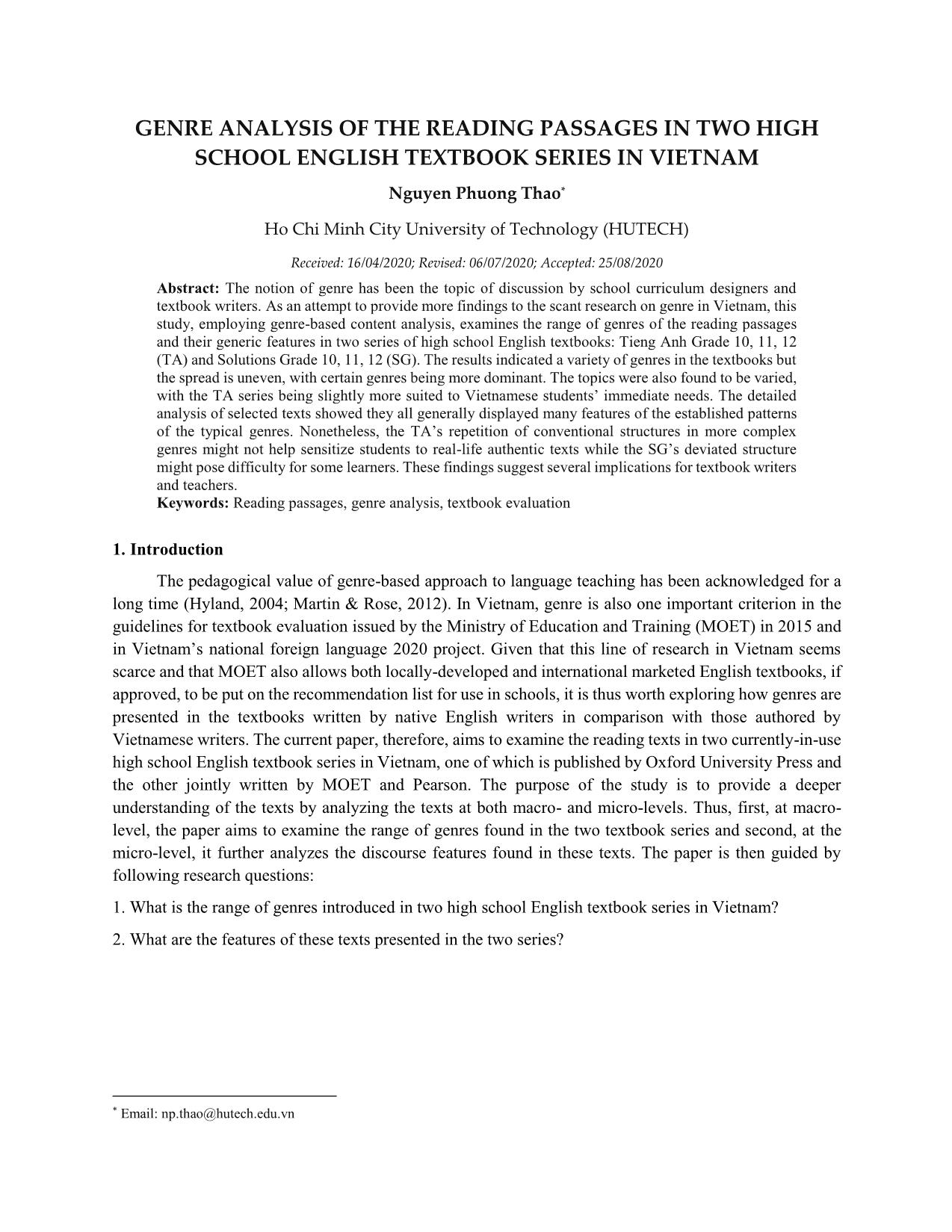
Trang 1
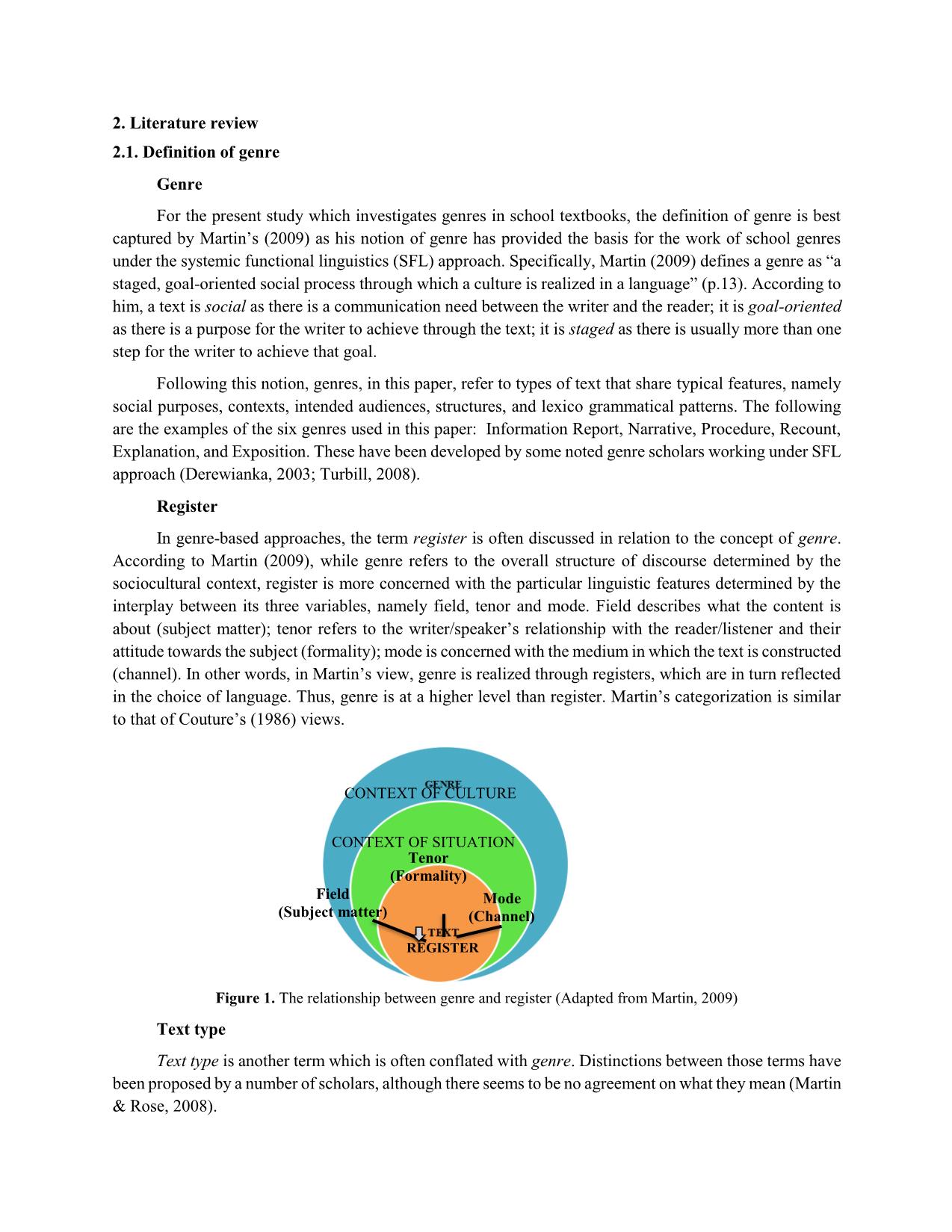
Trang 2
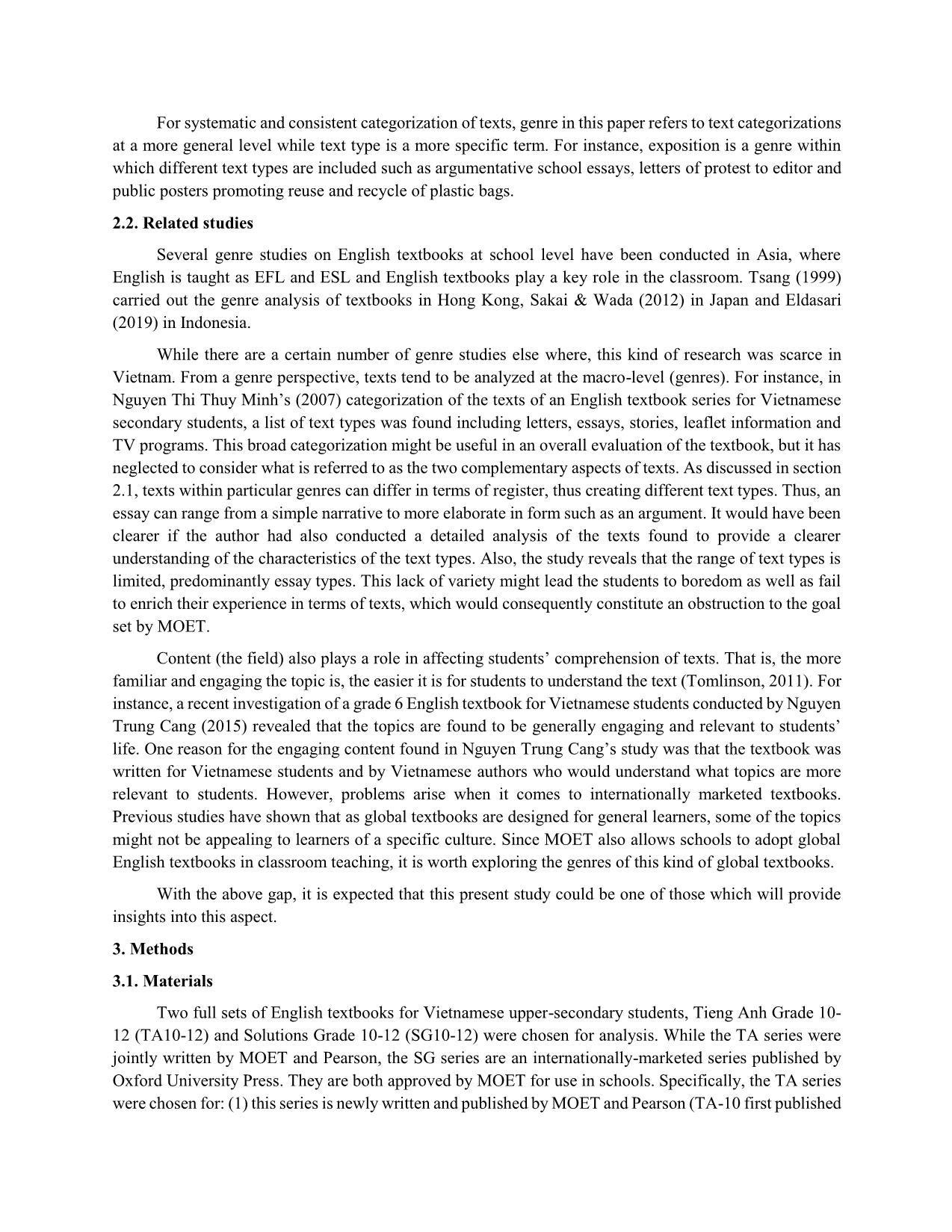
Trang 3
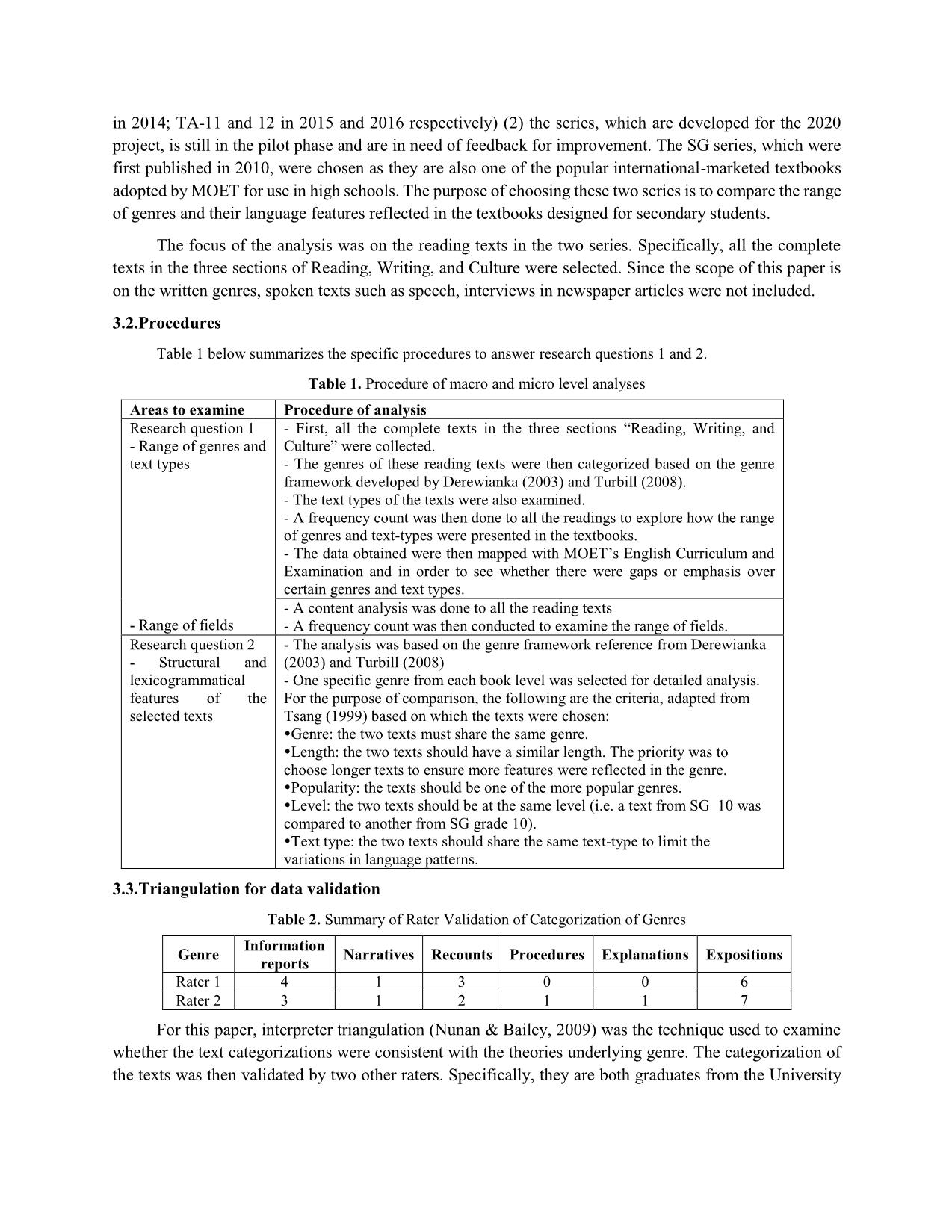
Trang 4
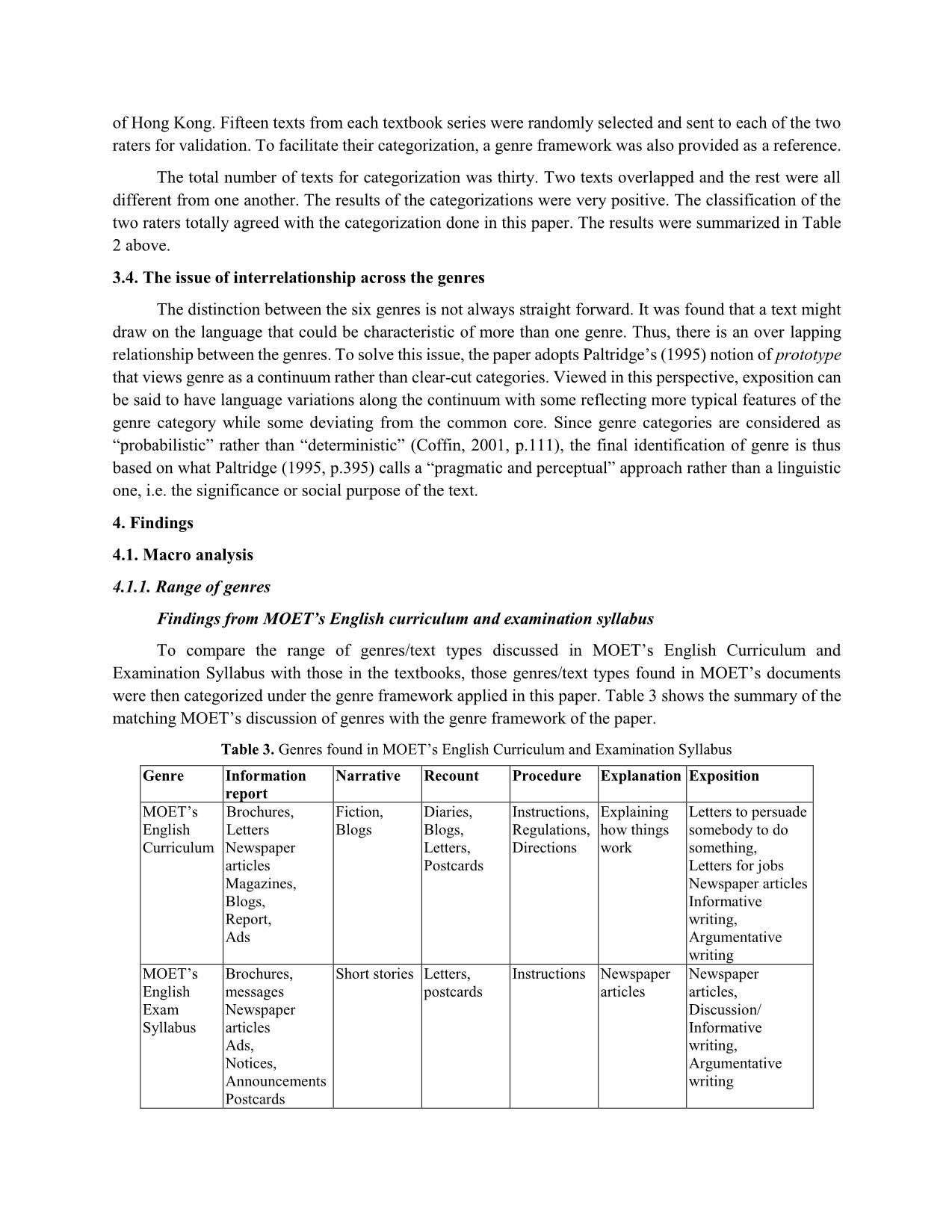
Trang 5
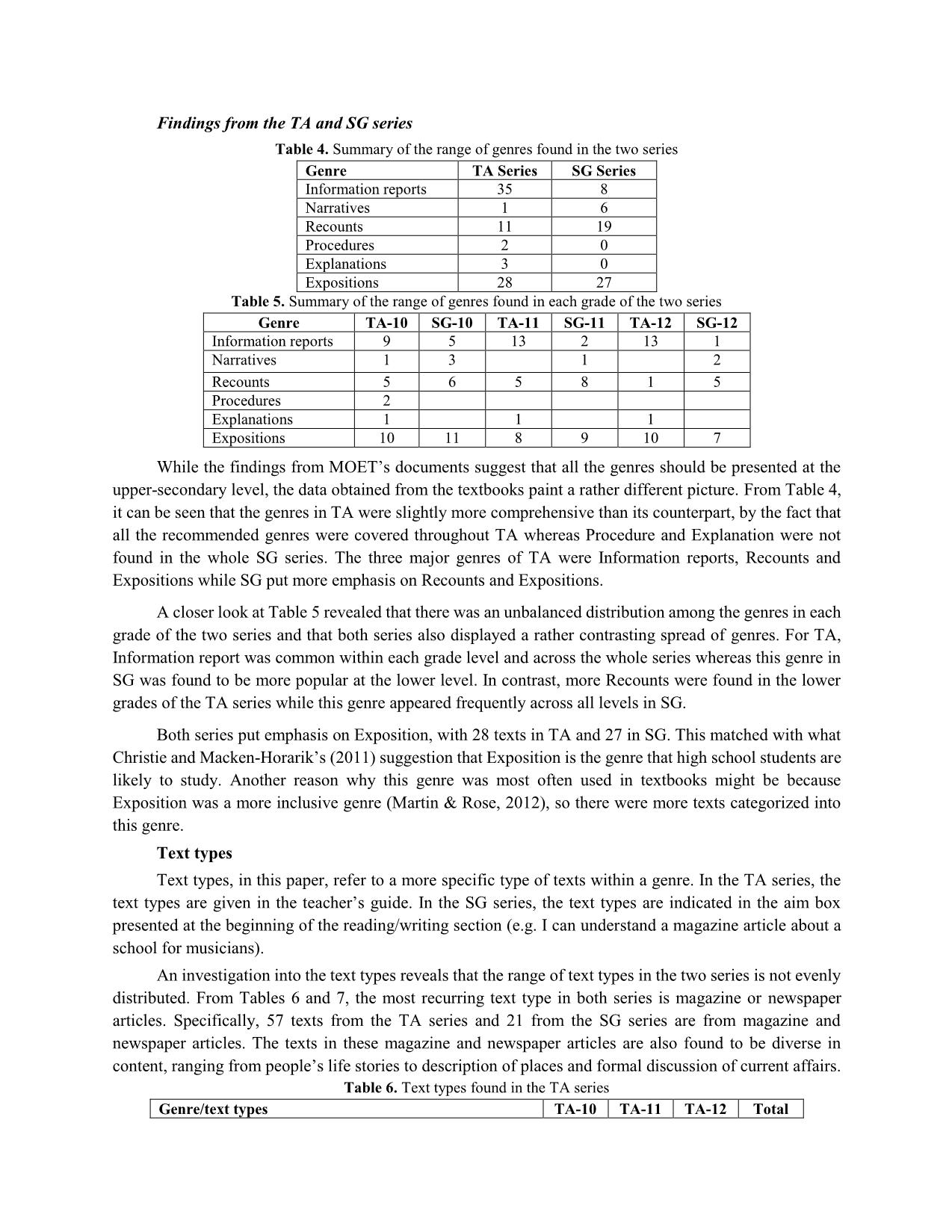
Trang 6
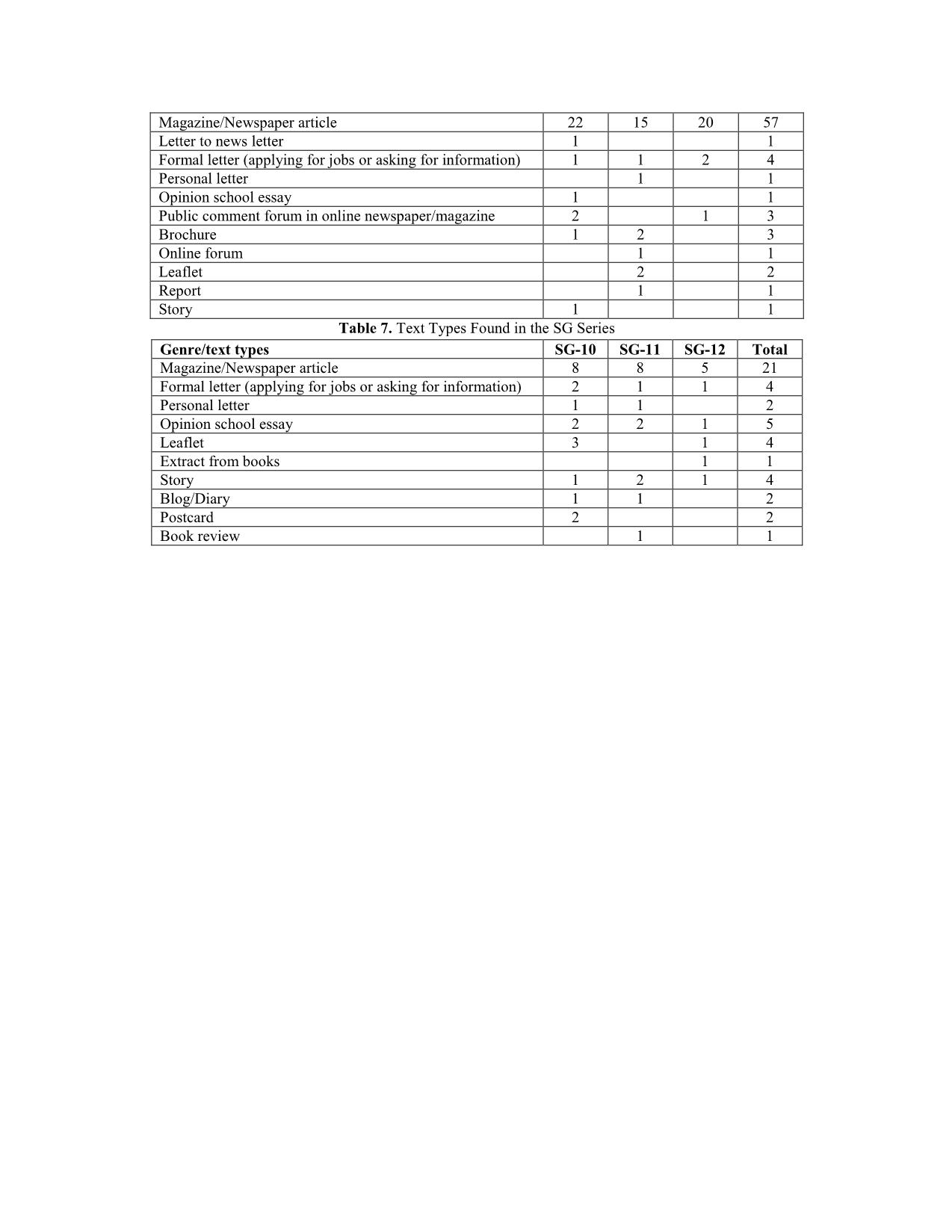
Trang 7
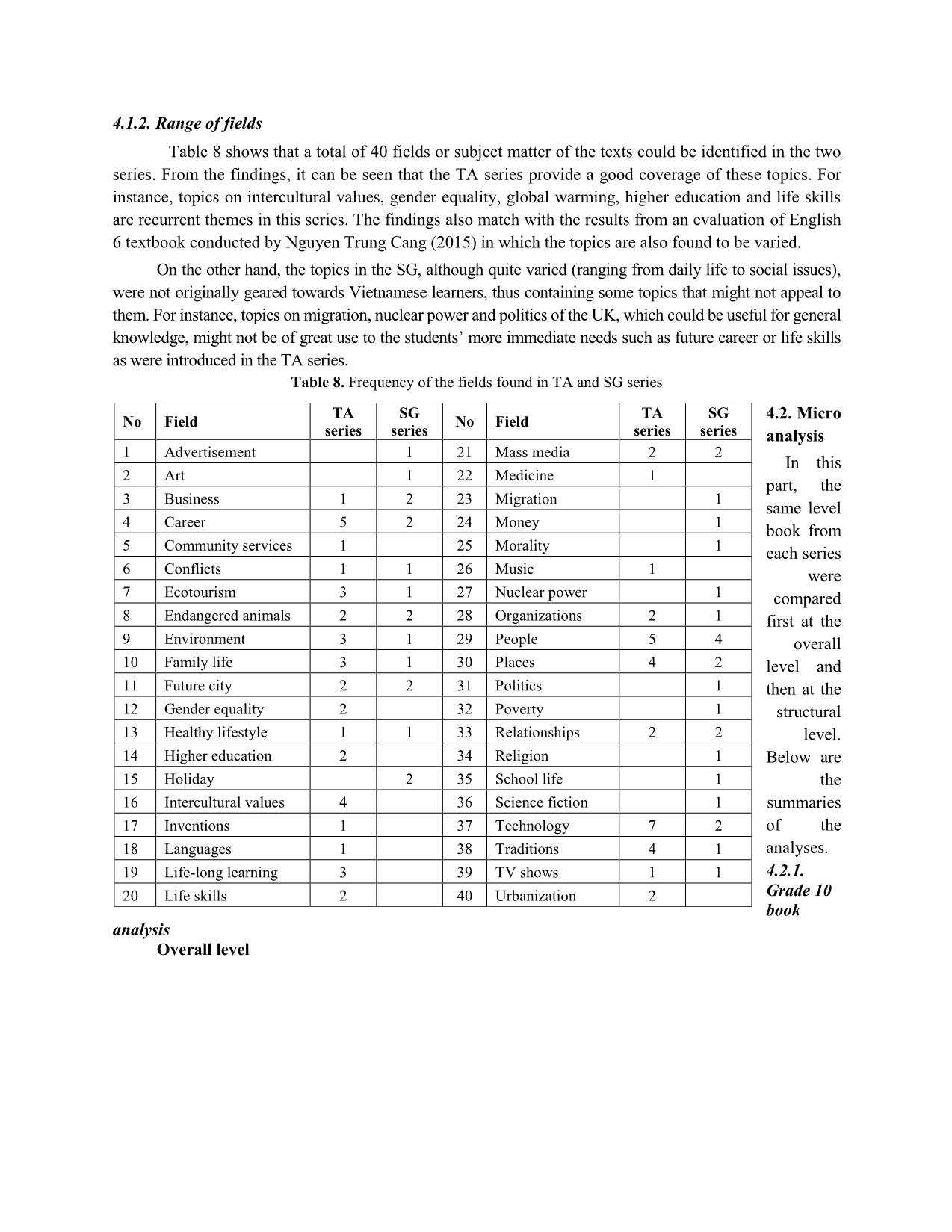
Trang 8
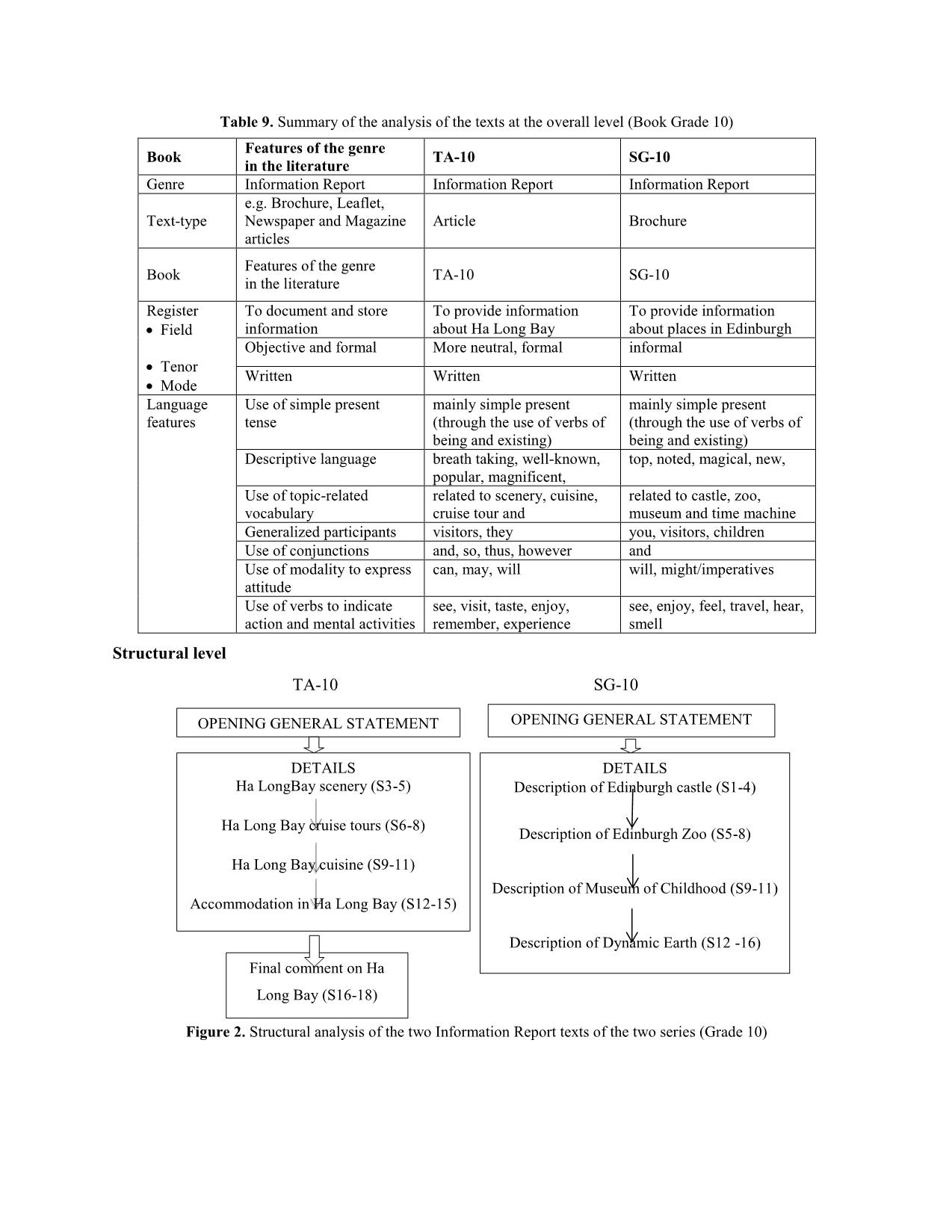
Trang 9
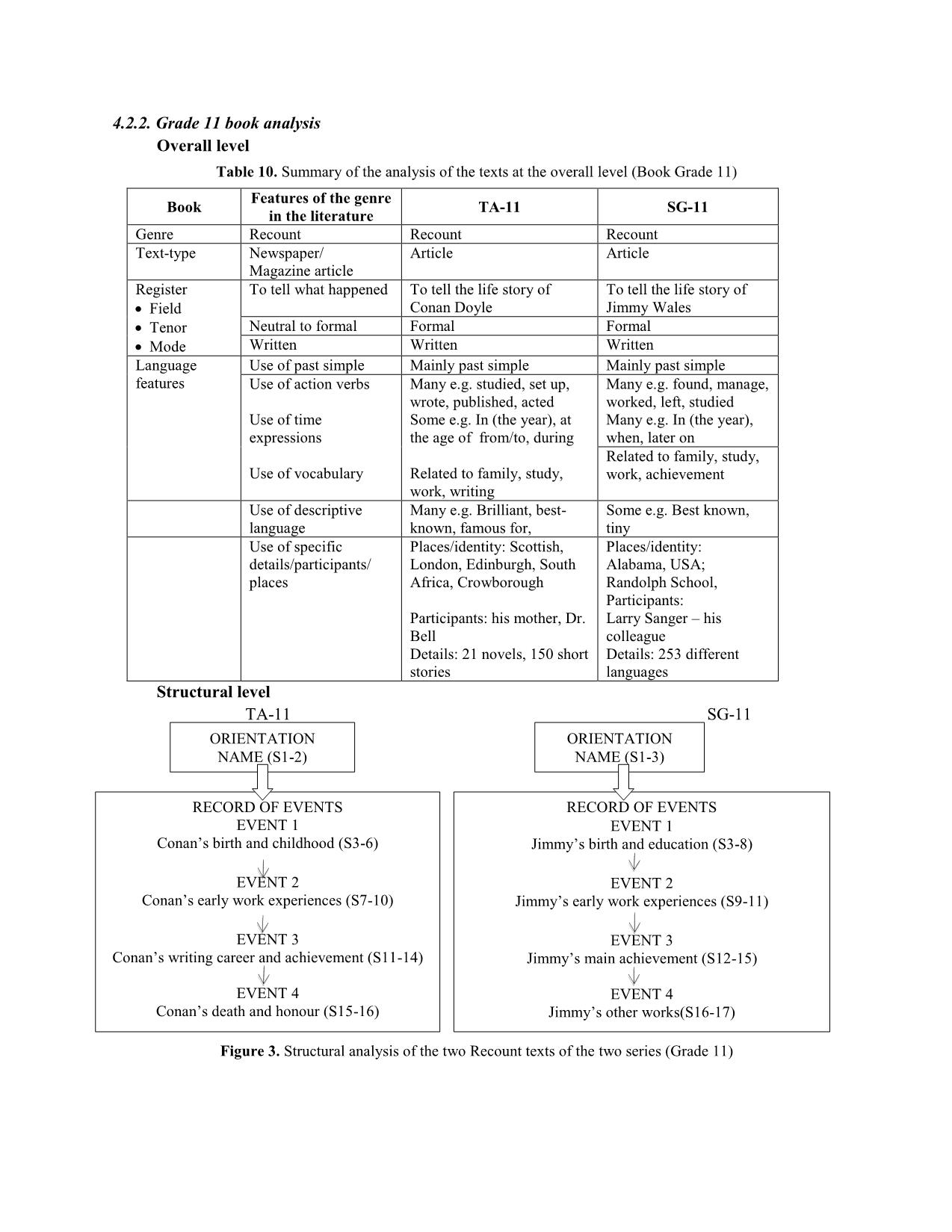
Trang 10
Tải về để xem bản đầy đủ
Tóm tắt nội dung tài liệu: Genre analysis of the reading passages in two high school english textbook series in Vietnam
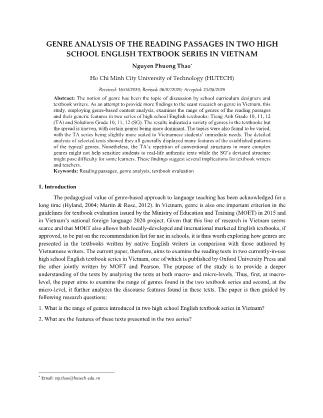
GENRE ANALYSIS OF THE READING PASSAGES IN TWO HIGH SCHOOL ENGLISH TEXTBOOK SERIES IN VIETNAM Nguyen Phuong Thao* Ho Chi Minh City University of Technology (HUTECH) Received: 16/04/2020; Revised: 06/07/2020; Accepted: 25/08/2020 Abstract: The notion of genre has been the topic of discussion by school curriculum designers and textbook writers. As an attempt to provide more findings to the scant research on genre in Vietnam, this study, employing genre-based content analysis, examines the range of genres of the reading passages and their generic features in two series of high school English textbooks: Tieng Anh Grade 10, 11, 12 (TA) and Solutions Grade 10, 11, 12 (SG). The results indicated a variety of genres in the textbooks but the spread is uneven, with certain genres being more dominant. The topics were also found to be varied, with the TA series being slightly more suited to Vietnamese students’ immediate needs. The detailed analysis of selected texts showed they all generally displayed many features of the established patterns of the typical genres. Nonetheless, the TA’s repetition of conventional structures in more complex genres might not help sensitize students to real-life authentic texts while the SG’s deviated structure might pose difficulty for some learners. These findings suggest several implications for textbook writers and teachers. Keywords: Reading passages, genre analysis, textbook evaluation 1. Introduction The pedagogical value of genre-based approach to language teaching has been acknowledged for a long time (Hyland, 2004; Martin & Rose, 2012). In Vietnam, genre is also one important criterion in the guidelines for textbook evaluation issued by the Ministry of Education and Training (MOET) in 2015 and in Vietnam’s national foreign language 2020 project. Given that this line of research in Vietnam seems scarce and that MOET also allows both locally-developed and international marketed English textbooks, if approved, to be put on the recommendation list for use in schools, it is thus worth exploring how genres are presented in the textbooks written by native English writers in comparison with those authored by Vietnamese writers. The current paper, therefore, aims to examine the reading texts in two currently-in-use high school English textbook series in Vietnam, one of which is published by Oxford University Press and the other jointly written by MOET and Pearson. The purpose of the study is to provide a deeper understanding of the texts by analyzing the texts at both macro- and micro-levels. Thus, first, at macro- level, the paper aims to examine the range of genres found in the two textbook series and second, at the micro-level, it further analyzes the discourse features found in these texts. The paper is then guided by following research questions: 1. What is the range of genres introduced in two high school English textbook series in Vietnam? 2. What are the features of these texts presented in the two series? * Email: np.thao@hutech.edu.vn 2. Literature review 2.1. Definition of genre Genre For the present study which investigates genres in school textbooks, the definition of genre is best captured by Martin’s (2009) as his notion of genre has provided the basis for the work of school genres under the systemic functional linguistics (SFL) approach. Specifically, Martin (2009) defines a genre as “a staged, goal-oriented social process through which a culture is realized in a language” (p.13). According to him, a text is social as there is a communication need between the writer and the reader; it is goal-oriented as there is a purpose for the writer to achieve through the text; it is staged as there is usually more than one step for the writer to achieve that goal. Following this notion, genres, in this paper, refer to types of text that share typical features, namely social purposes, contexts, intended audiences, structures, and lexico grammatical patterns. The following are the examples of the six genres used in this paper: Information Report, Narrative, Procedure, Recount, Explanation, and Exposition. These have been developed by some noted genre scholars working under SFL approach (Derewianka, 2003; Turbill, 2008). Register In genre-based approaches, the term register is often discussed in relation to the concept of genre. According to Martin (2009), while genre refers to the overall structure of discourse determined by the sociocultural context, register is more concerned with the particular linguistic features determined by the interplay between its three variables, namely field, tenor and mode. Field describes what the content is about (subject matter); tenor refers to the writer/speaker’s relationship with the reader/listener and their attitude towards the subject (formality); mode is concerned with the medium in which the text is constructed (channel). In other words, in Martin’s view, genre is realized through registers, which are in turn reflected in the choice of language. Thus, genre is at a higher level than register. Martin’s categorization is similar to that of Couture’s (1986) views. Figure 1. The relationship between genre and register (Adapted from Martin, 2009) Text type Text type is another term which is often conflated with genre. Distinctions between those terms have been proposed by a number of scholars, although there seems to be no agreement on what they mean (Martin & Rose, 2008). REGISTER Field (Subject matter) Tenor (Formality) Mode (Channel) CONTEXT OF SITUATION CONTEXT OF CULTURE For systematic and consistent categorization of texts, genre in this paper refers to text categorizations at a more general level while text type is a more specific term. For instance, exposition is a genre within which different text types are included such as argumentative school essays, letters o ... l genres should also be reviewed in upper levels and more even spread should be achieved. The last finding involves the limited distribution of Explanation. Unlike Narrative and Procedure, which are both the receptive and productive genre as shown in MOET’s examination syllabus. Explanation, which provides learners with information about how things work, belongs to the receptive genre. For instance, one text in TA explains how soot - black carbon can cause global warming. They are not asked to produce this type. Thus, this could be the reason why TA only have 3 texts in the whole series. The lack of Explanation in SG could be because SG was geared towards general English, not for CLIL (Content and Language Integrated Learning), in which more Explanation texts that explain reasons for phenomena would be covered. In terms of text types, both series had an extensive use of magazine and newspaper articles. As recommended by MOET, there are also other text types besides articles that are relevant to students’ needs such as blogs, posters, or brochures, and especially fiction texts. In the present study, while there was no literary texts in TA, SG did include across the levels, albeit minimally. With regard tothe range of fields, the findings reveal that both series covered a wide variety of topics. Among the 40 fields identified, certain localized fields for Vietnamese students were emphasized throughout the TA series. The scope of content in SG, on the other hand, demonstrated quite a Western- oriented focus, for instance, nuclear power and migration. This could be explained by the fact that SG was authored by foreign writers and TA was locally developed. Regarding research question 2, in order to explore the structural and linguistic features of the genres, a micro level analysis was conducted to some selected genres in the series. For book grade 10 The chosen genre was Information Report, a common genre in Grade 10, which provides learners with descriptions of things. Based on the summary in Table 9, and Figure 2 in section 4.2.1, it was found that both Information Report texts were generally in line with the typical genre in the literature. Specifically, at the overall level, both contents were about the description of a place of interest for tourists, namely Edinburgh in SG and Ha Long Bay in TA. The mode of the two texts were written form. Nevertheless, two texts have minor linguistic variations. The TA’s text had more descriptive language than the SG’s text. This findings of extensive use of adjectives was in line with Ip’s (2008), which pointed out that in tourism, destinations tend to be exaggerated with positive words. Some examples are: “superb experience, luxury cruise ship, breathtaking view” in the TA’s text and “top attraction, a magical world, and towering glaciers” in the SG’s text. The tenor of SG, on the other hand, was more in accordance with the genre exemplary than its counterpart, as reflected in the use of the second-pronoun “you” and the imperative in the text. These are typical features of tourism brochures (Terauchi, Maswana, & Yamada, 2017). As this writing aims to persuade people to come to visit the place, the use of “you” and the imperative made the reader feel personally engaged as if they were having a conversation with the writers. The lack of these features in the TA’s text made it slightly less authentic. At the structural level, both texts followed the generic features of Information Report in the literature. They had the introduction or topic at the beginning, followed by the detailed description of different aspects of the place. For book grade 11 The selected genre was Recount, specifically Biography, which recounts a person’s life stages. Bases on the summaryin Table 10 and Figure 3 in section 4.2.2, the findings suggest both texts matched well with the description in the literature in terms of structural and linguistic features. Both texts followed the pattern of Orientation Record of events. The TA text started with an orientation that provided contextual background information about Conan Doyle – a famous dead writer, followed by a record of his life events from his birth to his death. The same pattern was found in the SG’s text about Jimmy Wales – an American Internet entrepreneur. The life stories of these people were presented in time order, as reflected in the wide use of time adverbials in both texts and past tenses, thus maintaining the narrative style of Recount. As such, the thematic development took the form of a zigzag pattern (Eggins, 2004). That is, the new subsequent events were built on the previously introduced information, thus creating for this recount what Eggins calls “a sense of cumulative development” (p.325). Also, both texts had similarity in the only use of third-person pronoun and declaratives, in the absence of modal verbs, and in the large number of nominalizations. The tenor of both texts, therefore, was formal. For book grade 12 The selected genre was Exposition, the social purpose of which is to discuss or argue for or against a particular point of view. Specifically, both texts were discussion texts, in which the TA’s text discussed two contrasting attitudes towards robots and SG discussed opinions about advertising in school. Based on the summary in Table 11 and Figure 4 in section 4.2.3, both texts were found to reflect the linguistics features of the genre such as the use of third-person pronouns in presenting arguments, nominalizations, modality, and passive voice. All of these contributed to the formality of the texts. At the structural level, the TA text was more in line with the established pattern, following the traditional pattern of Thesis Arguments Conclusion. The SG text, on the other hand, did not have an explicitly stated thesis and conclusion. These findings suggest that the TA’s text structure would lay a good foundation for the future argumentative structure students will be likely to encounter in university, which is called the “three-stage essay” (Hyland, 1990). This structure, however, was later problematized by Schneer (2014) who concluded that this generalized structure did not reflect real-world argumentative writing, which can take various forms. This was shown in the findings from the SG’s text, in which there was an implicit thesis in the introduction and no conclusion. The reason for such deviation could be that the text was adapted from an authentic newspaper article. This finding was corroborated by Myskow and Gordon (2009) and Schneer (2014), who found that the structure of nonacademic argumentative writing was significantly contrasting with the traditional three-stage template. Such deviation might at first pose difficulties for learners who have been taught the conventional structure. The findings suggest that teachers need to familiarize high school students with the multifariousness of Exposition by providing them with the opportunity to research different texts and discuss in class in order to raise genre awareness. 6. Conclusion The findings of this study, employing genre-based content analysis, unraveled that both textbook series had a lopsided range of genres and text types. Certain genres, namely Information Report, Recount and Exposition were more dominant than others. Additionally, both series lacked literary texts and had extensive use of newspaper/articles. The topics of both series were found to be varied, with TA’s focus on Vietnamese students’ immediate needs and SG’s on the West. The micro analysis of the texts also revealed that for simpler genres such as Information Report and Recount, both series generally matched well with the convention but variations were found in a more complex genre (Exposition) for SG. Some implications within this study are drawn. For textbook writers, the uneven distribution could deprive students of the opportunity to enhance their genre knowledge, thus it is suggested that future textbook revision should focus on expansion of the spread of genres and text types. For teachers, the results clearly show that no textbook series was superior to others in all aspects. It is thus reasonable to suggest that teachers should not strictly adhere to a single textbook and are encouraged to utilize the best features of TA and SG depending on the students’ levels. Teachers need to have a consciousness of genre and register in order to make an informed choice of learning texts for students. This study still bears some limitations. It has only examined two high school English textbooks out of many other series. Also, the paper investigated only complete written genres, excluding the spoken genres and those texts which were either too short and fragmented or had the sentences removed for the purpose of activity practice. Thus, the results should be treated with caution. Future studies are warranted to obtain a clearer understanding of genre in English textbooks. References Christie, F., & Macken-Horarik, M. (2011). Disciplinarity and the case of school subject English. In F. Christie & K. Maton (Eds), Disciplinarity: Functional linguistic and sociological perspectives (pp. 175- 196). London, England: Continuum. Coffin, C. (2001). Theoretical approaches to written language: A TESOL perspective. In A. Burns, & C. Coffin (Eds.), Analyzing English in a global context: A reader (pp. 93-122). London, England: Routledge. Couture, B. (1986). Functional approaches to writing: Research perspectives. Norwood, NJ: Ablex. Derewianka, B. (2003). Trends and issues in genre‐based approaches. RELC Journal, 34(2), 133-154. Eggins, S. (2004). Introduction to systemic functional linguistics. London, England: A&C Black. Eldasari, D.I. (2019). Genre analysis on reading passages of English textbook Talk Active. Raden Intan State Islamic University, Lampung, Indonesia. Hyland, K. (1990). A genre description of the argumentative essay. RELC Journal, 21, 66-78. Doi:10.1177/003368829002100105. Hyland, K. (2004). Genre and second language writing. Ann Arbor, MI: University of Michigan Press. Ip, J.Y.L. (2008). Analyzing tourism discourse: A case study of a Hong Kong travel brochure. LCOM Papers, 1, 1-19. Martin, J.R. (2009). Genre and language learning: A social semiotic perspective. Linguistics and Education, 20(1), 10-21. Martin, J.R., & Rose, D. (2008). Genre relations: Mapping culture. London, England: Equinox. Martin, J.R., & Rose, D. (2012). Learning to write, reading to learn: Genre, knowledge and pedagogy in the Sydney school. London, England: Equinox. Ministry of Education and Training (MOET) (2015). Quy định bộ tiêu chí đánh giá sách giáo khoa tiếng Anh giáo dục phổ thông. Retrieved from: https://thuvienphapluat.vn/van-ban/giao-duc/thong-tu-31-2015- tt-bgddt-bo-tieu-chi-danh-gia-sach-giao-khoa-tieng-anh-giao-duc-pho-thong-299108.aspx. Myskow, G., & Gordon, K. (2009). A focus on purpose: Using a genre approach in an EFL writing class. ELT Journal, 64(3), 283-292. Nguyen Trung Cang (2015). An evaluation of the textbook English 6: A case study from secondary schools in the Mekong Delta provinces of Vietnam. Unpublished Thesis. University of Sheffield, UK. Nguyen Thi Thuy Minh (2007). Textbook evaluation: The case of English textbooks currently in use in Vietnam’s upper-secondary schools. Unpublished Manuscript. SEAMEO RELC, Singapore. Nunan, D., & Bailey, K.M. (2009). Exploring second language classroom research: A comprehensive guide. Boston, MA: Cengage. Paltridge, B. (1995). Working with genre: A pragmatic perspective. Journal of Pragmatics, 24(4), 393-406. Sakai, H., & Wada, J. (2012). A genre/text-type analysis of junior high school English textbooks. JALT Journal, 34(2), 209-238. Schneer, D. (2014). Rethinking the argumentative essay. TESOL Journal, 5(4), 1–35. Terauchi, H., Maswana, S., & Yamada, M. (2017). A genre-based study of tourism language in English textbooks. Journal of Global Tourism Research, 2(2), 115-122. Tomlinson, B. (2011). Materials development in language teaching. Cambridge, England: Cambridge University Press. Tsang, W.W. (1999). Genre analysis of the reading passages in English textbook series in Hong Kong. Unpublished Thesis. The University of Hong Kong, China. Turbill, J. (2008). Features of common text types. In V. Noak & M. Nicole (Eds.), Writers in schools. Retrieved from: PETAA database. PHÂN TÍCH THỂ LOẠI CÁC BÀI ĐỌC TRONG HAI BỘ SÁCH GIÁO KHOA TIẾNG ANH TRUNG HỌC PHỔ THÔNG Tóm tắt: Thể loại là chủ đề thường được thảo luận bởi nhà thiết kế chương trình học và tác giả sách giáo khoa. Để cung cấp thông tin cho nghiên cứu ít ỏi về thể loại ở Việt Nam, nghiên cứu này, sử dụng phương pháp phân tích nội dung, khám phá sự đa dạng về thể loại của các bài đọc và các đặc điểm về cấu trúc, ngữ pháp và từ vựng của chúng giữa hai loại sách giáo khoa tiếng Anh trung học phổ thông: Tiếng Anh Lớp 10, 11, 12 và Solutions Lớp 10, 11, 12. Kết quả cho thấy hai bộ sách đều đề cập đến các thể loại được đề nghị trong sách giáo khoa nhưng sự phân bổ thì không đồng đều, với một số thể loại chiếm ưu thế hơn. Các chủ đề cũng rất đa dạng và bộ TA phù hợp hơn với nhu cầu cấp thiết cho học sinh Việt Nam. Phân tích chi tiết của các bài đọc được chọn cũng cho thấy tất cả nhìn chung đều hiển thị nhiều đặc điểm tương đồng với các thể loại điển hình. Tuy nhiên, việc lặp đi lặp lại các cấu trúc đơn giản trong các thể loại phức tạp hơn trong bộ TA có thể không giúp học sinh quen với các cấu trúc của thể loại này trong thực tế. Trong khi cấu trúc phức tạp này ở bộ SG có thể gây khó khăn cho một số học sinh. Những kết quả này sẽ giúp ích cho tác giả sách và giáo viên. Từ khóa: Đoạn bài đọc, phân tích thể loại, đánh giá giáo trình
File đính kèm:
 genre_analysis_of_the_reading_passages_in_two_high_school_en.pdf
genre_analysis_of_the_reading_passages_in_two_high_school_en.pdf

